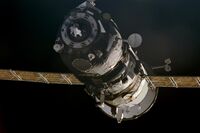Engineering:Progress-M1
 A Progress-M1 spacecraft | |
| Manufacturer | RKK Energia |
|---|---|
| Country of origin | |
| Operator | Roskosmos |
| Applications | Space station logistics |
| Specifications | |
| Design life | 6 months |
| Regime | Low Earth |
| Production | |
| Status | Retired |
| Built | 11F615A55: 11 11F615A70: 0 |
| Launched | 11F615A55: 11 11F615A60: 0 |
| Retired | 11F615A55: 11 |
| Maiden launch | 11F615A55: Progress M1-1 (2000) 11F615A70: Progress M1-01M (2011) (cancelled) |
| Last launch | 11F615A55: Progress M1-11 (2004) |
| Last retirement | 11F615A55: Progress M1-11 (2004) |
| Related spacecraft | |
| Derived from | Progress-M |
Progress-M1 (Russian: Прогресс-М1, GRAU indices 11F615A55 and 11F615A70), also known as Progress 7K-TGM1, is a Russian spacecraft which is used to resupply space stations. It is a variant of the Progress spacecraft, derived from the Progress-M, but modified to carry more UDMH and N2O4 propellant for refuelling the International Space Station instead of other cargoes such as water. A Progress M1 11F615A55 spacecraft could carry up to 1,700 kilograms (3,700 lb) of propellant in eight mid-section refuelling tanks,[1] compared to the 850 kilograms (1,870 lb) that a Progress-M of the same generation could carry.[2] This propellant can be transferred to the Space Station's own propulsion system through fluid connectors in the docking ring, or it can alternatively be used by the Progress' thrusters to boost the station altitude or to change its orientation, or attitude, in space. In addition to propellant, the spacecraft can also carry up to 1,800 kilograms (4,000 lb) (6 cubic meters volume) of supplies in its forward pressurized cargo module (including a maximum of 40 kilograms (88 lb) of compressed air), but the combination of pressurized cargo and refuelling propellant cannot exceed 2,500 kilograms (5,500 lb) or the maximum capability of the launch vehicle. The tare weight of Progress-M1 is 5,050 kilograms (11,130 lb).[3] Its KTDU-80 engine has a thrust of 2,950 newtons (660 lbf) and uses up to 892 kilograms (1,967 lb) of propellant carried in four integrated spherical tanks for maneuvers such as docking and deorbiting the craft; 185 kilograms (408 lb) to 250 kilograms (550 lb) is typically left unused and hence available for the space station.

The Progress-M1 11F615A70 is a modernised variant of the earlier 11F615A55, with digital flight control systems replacing the earlier analogue ones. The older 11F615A55 spacecraft is no longer in use. It made eleven flights, the last of which, Progress M1-11, was deorbited in June 2004. The 11F615A70 was scheduled to make its first flight, Progress M1-01M, in 2011 but was cancelled.
Of the eleven 11F615A55 spacecraft launched, three flew to Mir, with the remainder being used to resupply the International Space Station.[4] Ten of the spacecraft were used for traditional resupply missions, whilst the eleventh, Progress M1-5, was used instead to deorbit the Mir space station.[5]
Progress-M1 spacecraft are launched by Soyuz rockets. Eight of the 11F615A55 spacecraft were launched by the Soyuz-U variant, whilst the remaining three; the sixth, seventh and ninth spacecraft, flew on the Soyuz-FG.[6] 11F615A70 launches are expected to use the Soyuz-2 but was cancelled.
See also
- Automated Transfer Vehicle
- Cygnus spacecraft
- SpaceX Dragon
References
- ↑ Krebs, Gunter. "Progress-M1 1 - 11 (11F615A55, 7KTGM1)". Gunter's Space Page. http://space.skyrocket.de/doc_sdat/progress-m1.htm.
- ↑ Krebs, Gunter. "Progress-M 1 - 13, 15 - 37, 39 - 67 (11F615A55, 7KTGM)". Gunter's Space Page. http://space.skyrocket.de/doc_sdat/progress-m.htm.
- ↑ Jorgensen, Catherine A., ed. "International Space Station Evolution Data Book Volume I. Baseline Design Revision A (page 4.62)". NASA/SP-2000-6109. https://ntrs.nasa.gov/archive/nasa/casi.ntrs.nasa.gov/20000120038.pdf.
- ↑ Wade, Mark. "Progress M1". Encyclopedia Astronautica. http://www.astronautix.com/craft/proessm1.htm.
- ↑ Zak, Anatoly (2001-01-24). "Mir "burial" mission launched". Spaceflight Now. http://spaceflightnow.com/mir/010124progup/.
- ↑ McDowell, Jonathan. "Launch Log". Jonathan's Space Page. http://planet4589.org/space/log/launchlog.txt.
 |


